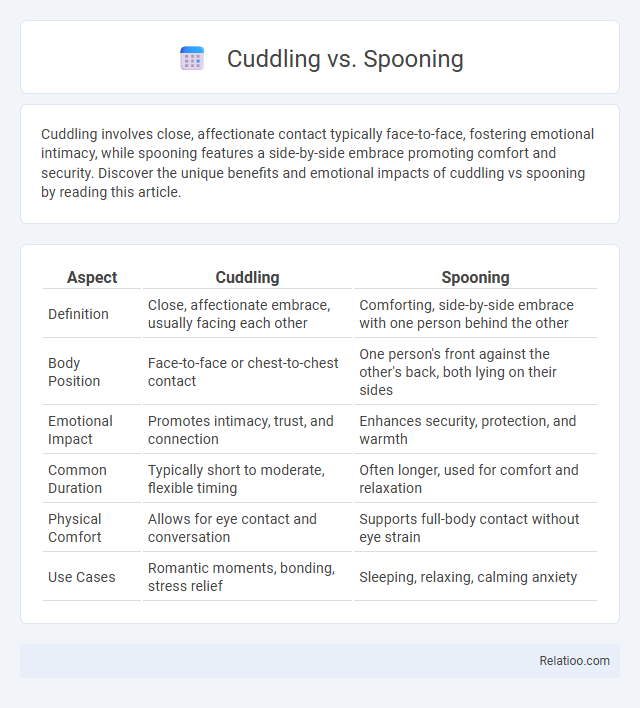Cuddling involves close, affectionate contact typically face-to-face, fostering emotional intimacy, while spooning features a side-by-side embrace promoting comfort and security. Discover the unique benefits and emotional impacts of cuddling vs spooning by reading this article.
Table of Comparison
| Aspect | Cuddling | Spooning |
|---|---|---|
| Definition | Close, affectionate embrace, usually facing each other | Comforting, side-by-side embrace with one person behind the other |
| Body Position | Face-to-face or chest-to-chest contact | One person's front against the other's back, both lying on their sides |
| Emotional Impact | Promotes intimacy, trust, and connection | Enhances security, protection, and warmth |
| Common Duration | Typically short to moderate, flexible timing | Often longer, used for comfort and relaxation |
| Physical Comfort | Allows for eye contact and conversation | Supports full-body contact without eye strain |
| Use Cases | Romantic moments, bonding, stress relief | Sleeping, relaxing, calming anxiety |
Understanding Cuddling and Spooning: Key Differences
Understanding cuddling and spooning involves recognizing their unique physical and emotional dynamics; cuddling typically involves facing each other, promoting direct eye contact and a sense of closeness, while spooning positions both partners lying on their sides, with one person's back against the other's, creating a protective and intimate embrace. You benefit from knowing these key differences to enhance your bonding experience by choosing the type of touch that best suits your comfort and emotional needs. Both forms of physical affection release oxytocin, fostering connection and reducing stress, but the choice between cuddling and spooning depends on your desired level of intimacy and body contact.
The Science Behind Physical Affection
Physical affection such as cuddling, spooning, and hugging triggers the release of oxytocin, a hormone that reduces stress and promotes bonding in your brain. Cuddling involves close body contact with face-to-face interaction, while spooning is a side-by-side embrace that provides full-body warmth and security. Both forms of physical touch activate neural pathways that enhance emotional connection and improve mental health by lowering cortisol levels.
Emotional Benefits of Cuddling
Cuddling, including spooning and other close physical embraces, promotes emotional well-being by increasing oxytocin levels, which reduces stress and fosters feelings of trust and security. Spooning, a form of cuddling with one partner's body curved around the other, enhances intimacy and emotional bonding through prolonged skin-to-skin contact. Overall, these affectionate behaviors strengthen relationship satisfaction and create a comforting sense of connection, essential for mental health and emotional resilience.
Health Benefits of Spooning
Spooning offers unique health benefits by promoting relaxation and reducing stress through close physical contact, which increases oxytocin levels and lowers cortisol. Your heart rate can stabilize, and blood pressure may decrease, contributing to overall cardiovascular health. Engaging in spooning improves sleep quality by creating a sense of security and comfort, enhancing emotional well-being.
Cuddling Positions vs. Spooning Positions
Cuddling positions vary from face-to-face embraces to side-by-side snuggles, promoting intimacy and warmth through direct body contact. Spooning positions involve one partner lying behind the other, creating a protective, enveloping posture that fosters comfort and security. Your choice between cuddling positions and spooning positions can influence the level of closeness and emotional bonding experienced during physical affection.
Intimacy Levels: Cuddling vs. Spooning
Cuddling provides a moderate level of intimacy characterized by face-to-face contact and open body language, fostering emotional connection and comfort. Spooning involves a higher intimacy level with a side-by-side, curved body posture, promoting warmth, security, and closeness through full-body contact. Both forms of physical affection enhance bonding, but spooning is often perceived as more intimate due to its enveloping embrace and synchronized rhythm.
Cuddling and Spooning in Relationships
Cuddling and spooning both enhance intimacy and emotional bonding in relationships through physical closeness, but they differ in posture and intention; cuddling often involves face-to-face contact promoting eye contact and verbal communication, while spooning, characterized by one partner embracing the other from behind, provides a sense of protection and comfort. Studies indicate cuddling releases oxytocin, reducing stress and fostering attachment, whereas spooning's enveloping embrace strengthens feelings of security and trust between partners. Both practices contribute significantly to relationship satisfaction by nurturing emotional connection and physical affection without requiring verbal interaction.
When to Choose Cuddling Over Spooning
Choose cuddling over spooning when seeking mutual face-to-face intimacy that promotes emotional connection and eye contact. Cuddling allows both partners to feel equally embraced, fostering a sense of security and warmth without the restrictive position of spooning. It's ideal for moments when comfort and open communication are prioritized over the protective or protective nature of spooning.
Common Myths About Cuddling and Spooning
Common myths about cuddling and spooning include the misconception that these intimate acts are solely romantic or sexual, when in fact they also promote emotional bonding and stress relief through oxytocin release. Another false belief is that cuddling requires physical compatibility or specific body types, but it is a universally accessible form of affection that benefits mental health regardless of size or shape. Your understanding of these myths allows you to embrace cuddling and spooning as powerful tools for connection and well-being beyond popular assumptions.
Tips for Enhancing Your Cuddling and Spooning Experience
To enhance your cuddling and spooning experience, prioritize open communication about comfort levels and preferred positions to ensure mutual relaxation. Incorporate soft pillows and cozy blankets to create a warm, inviting environment that encourages prolonged intimacy. Experiment with gentle touch and synchronized breathing to deepen emotional connection and physical comfort during these affectionate moments.

Infographic: Cuddling vs Spooning
 relatioo.com
relatioo.com